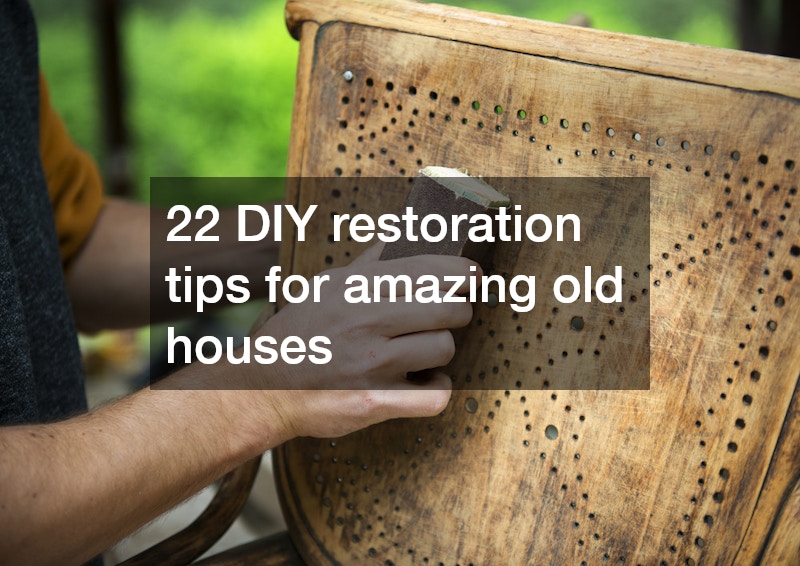22 DIY Restoration Tips for Amazing Old Homes
Restoring an old home is a journey that combines creativity, skill, and the satisfaction of bringing a space back to life. These homes, with their timeless charm and unique character, are often a testament to architectural history and craftsmanship. However, the passage of time can leave them in need of care and restoration. Whether you’re aiming to maintain historical accuracy or give your home a functional, modern twist, there are countless ways to rejuvenate an older property.
Below, we’ve outlined 22 detailed DIY restoration tips to help you breathe new life into your home while preserving its charm. From structural fixes to aesthetic upgrades, these steps cover everything you need to know to make your restoration project a success.
1. Inspect the Foundation for Stability
The foundation is the backbone of any home, and it’s especially critical to check it in older properties. Over time, soil movement, weather changes, and natural wear can cause cracks, settling, or shifting. Walk around the property and inspect the walls and flooring for signs of uneven surfaces, cracks, or sagging.
If you notice significant issues, consult a structural engineer who can assess the situation. They may recommend underpinning or reinforcing the foundation. It’s important to address any foundation problems before moving on to other restoration projects to ensure your home’s long-term stability.
2. Update Outdated Plumbing Systems
Outdated plumbing is a common issue in older homes, where pipes may be made from materials like galvanised steel, which corrodes over time. Check for signs of leaks, rust, or reduced water pressure, which could indicate pipe deterioration.
Replace older pipes with modern materials like copper or PVC. These materials are durable and meet current plumbing standards. While basic plumbing repairs can often be done as a DIY project, major upgrades should be left to licensed professionals to ensure compliance with local building codes.
3. Restore Wooden Features
Timber elements such as floorboards, trims, and weatherboards add warmth and character to a home. Over time, however, wood can rot, warp, or loosen. Carefully inspect your home for signs of damage, such as discolouration, soft spots, or splintering.
When replacing rotten timber, opt for sustainably sourced hardwoods that closely match the original material. Sand and refinish wooden surfaces to restore their original beauty, using low-VOC, eco-friendly finishes for a polished and environmentally responsible result.
4. Repair and Reinforce Plaster Walls
Many older homes feature plaster walls, which are more durable than drywall but can crack over time due to structural shifts or humidity changes. Use a plaster patching compound for minor cracks and chips. For larger cracks or sagging sections, you may need to remove and reapply plaster.
If maintaining historical authenticity is important, consider consulting a heritage restoration specialist who can ensure the repairs align with the home’s original construction techniques.
5. Refinish Hardwood Floors
Hardwood floors are a signature feature of many older homes and can last for generations if properly maintained. Begin by sanding the surface to remove scratches, stains, and old finishes. Be cautious not to over-sand, as this can thin the boards and compromise their durability.
After sanding, apply a high-quality sealant or finish to protect the wood. Non-toxic, water-based finishes are a great option for reducing indoor air pollution while enhancing the natural beauty of the timber.
6. Inspect and Repair the Roof
A sturdy roof is essential to protect your home from the elements. Examine your roof for signs of damage, such as loose tiles, rusted metal sheets, or leaks. Regular maintenance of gutters and downpipes is also important to prevent water damage.
When replacing sections of the roof, choose materials that match the original design to maintain the home’s character. Safety should always be a priority during roof repairs—consider hiring professionals for complex or high-risk tasks.
7. Enhance Energy Efficiency with Modern Windows
Older homes often have single-pane windows that are inefficient at regulating indoor temperatures. Upgrading to double-glazed windows can improve insulation, reduce energy costs, and increase comfort.
If the original timber frames are still intact, you can retrofit them with new glass rather than replacing the entire window. This approach preserves the aesthetic while adding modern functionality.
8. Boost Insulation for Better Comfort
Older homes frequently lack proper insulation, resulting in temperature extremes during summer and winter. Adding insulation to the walls, floors, and ceilings can significantly improve comfort and reduce energy bills.
Eco-friendly insulation materials, such as Earthwool or recycled cellulose, are effective and sustainable choices. Be sure to seal any gaps or cracks before installing insulation to maximise its efficiency.
9. Maintain Clean and Functional Gutters
Blocked gutters can lead to serious water damage, especially in areas with heavy rainfall or leaf debris. Regularly inspect and clean your gutters to prevent clogs. Gutter guards are a simple and effective solution to minimise blockages.
If you’re replacing old gutters, consider materials like copper, which are both durable and visually appealing.
10. Address Moisture and Rising Damp
Moisture issues are common in older homes and can cause unsightly stains, peeling paint, or even structural damage. Identify the source of the moisture, whether it’s rising damp, roof leaks, or plumbing issues.
Treat affected areas with specialised cleaning products and ensure proper ventilation throughout the home to prevent future problems. Waterproof coatings or damp-proof membranes can also be applied to walls and floors for added protection.
11. Upgrade Chimneys and Fireplaces
Fireplaces are often a stunning feature in older homes, but they may require some TLC to remain functional. Clean the chimney thoroughly to remove soot and creosote, and inspect it for cracks or blockages.
Repairs may include re-pointing brickwork or replacing damaged flue liners. For added efficiency, consider installing a wood-burning stove or gas insert while maintaining the original fireplace surround.
12. Replace and Restore Door Hardware
Original door handles, locks, and hinges often show signs of rust or wear. Restore them by cleaning and polishing, or replace them with high-quality replicas that suit the home’s style.
For added security and convenience, you can install modern locking mechanisms, such as smart locks, while maintaining the traditional aesthetic.
13. Refresh Cabinetry with a Modern Touch
Cabinetry in kitchens and bathrooms often suffers from wear and tear over the years. Sand and repaint cabinets using durable, water-resistant paint in colours that suit the era of your home. Neutral tones and soft pastels are timeless options that work well in most interiors.
Adding new handles or hardware can further enhance the look while keeping costs low.
14. Create a Sustainable Garden
Landscaping plays a crucial role in the overall appeal of your home. Choose plants that thrive in your local climate, require minimal maintenance, and are drought-tolerant. Incorporating native plants not only adds beauty but also supports the local ecosystem.
Use recycled materials like bricks, stones, or timber for garden borders and pathways to add rustic charm and reduce waste.
15. Modernise Countertops with Style
Worn countertops can detract from the overall look of your kitchen or bathroom. Replace them with durable materials like engineered stone, stainless steel, or butcher block.
For a more budget-friendly option, consider re-tiling the countertops using ceramic tiles and a waterproof sealant. Select colours and patterns that harmonise with the home’s style.
16. Revitalise the Pantry
Older homes often feature pantries with wooden shelving that may be sagging or peeling. Reinforce the structure and repaint the shelves for a fresh appearance.
Modern storage solutions, such as pull-out baskets or adjustable shelving, can improve functionality while retaining the pantry’s charm.
17. Remove Old Wallpaper for a Fresh Look
Outdated wallpaper can make a room feel drab. Carefully strip it using a steamer or scraper, taking care not to damage the walls underneath.
Repaint the walls in light, neutral shades to create a sense of space and brightness. If you prefer wallpaper, opt for designs inspired by the home’s original era for an authentic touch.
18. Rejuvenate the Front Door
A well-maintained front door enhances curb appeal and sets the tone for your home. Sand and repaint the door in a bold, welcoming colour. Use a durable, weather-resistant paint to protect it from the elements.
Adding new hardware, such as a decorative knocker or updated locks, can complete the look.
19. Replace Worn Flooring
Carpets in older homes often harbour dust, allergens, and pests. Remove them to reveal original hardwood flooring underneath, if available. If new flooring is required, consider materials like bamboo or engineered timber, which are both sustainable and stylish.
For tiled areas, replacing worn or cracked tiles can significantly refresh the space.
20. Improve Interior and Exterior Lighting
Good lighting can transform the ambience of a home. Replace outdated fixtures with energy-efficient LED options, and consider adding pendant lights or sconces that complement the home’s design.
Skylights or larger windows can also bring more natural light into dim spaces, enhancing both aesthetics and functionality.
21. Create Functional Room Zones
Older homes often feature large open spaces or unusual layouts. Use furniture, screens, or rugs to define different zones for dining, lounging, or working.
This approach can make the space feel more organised and versatile while maintaining its charm.
22. Restore Fencing and Gates
The fencing and gates around your property are often the first impression visitors have. Repaint or replace worn sections and repair any structural issues.
If you prefer modern convenience, consider adding an automatic opening mechanism to the gate while retaining its traditional look.
Final Thoughts
Restoring an old home is a labour of love that requires patience, creativity, and attention to detail. By focusing on both structural and aesthetic improvements, you can create a space that is not only beautiful but also functional and efficient. Whether you choose to tackle the projects yourself or seek professional help, these tips will help guide you through the restoration process and ensure your home retains its timeless appeal for years to come.



